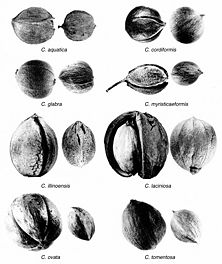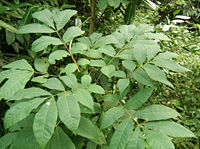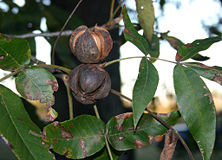Hickory
- For other meanings of Hickory please see Hickory (disambiguation).
| Hickory | ||||||||||||
|---|---|---|---|---|---|---|---|---|---|---|---|---|
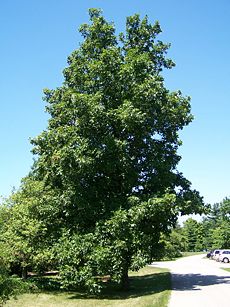 Hickory at Morton Arboretum
Accession 29-U-10 | ||||||||||||
| Scientific classification | ||||||||||||
| ||||||||||||
|
See text |
Trees in the genus Carya (from Ancient Greek κάρυον "nut") are commonly known as Hickory. The genus includes 17-19 species of deciduous trees with pinnately compound leaves and large nuts. A dozen or so species are native to North America (11–12 in the United States, 1 in Mexico), and 5–6 species from China and Indochina.
Another Asian species, Beaked Hickory, previously listed as Carya sinensis, is now treated in a separate genus Annamocarya, as Annamocarya sinensis.
Hickory flowers are small yellow-green catkins produced in spring. They are anemophilous and self-incompatible. The fruit is a globose or oval nut, 2–5 cm long and 1.5–3 cm diameter, enclosed in a four-valved husk which splits open at maturity. The nut shell is thick and bony in most species, thin in a few, notably C. illinoinensis; it is divided into two halves which split apart when the seed germinates.
Species and classification
In the APG system, genus Carya (and the whole Juglandaceae family) has been recently moved to the Fagales order.
- North America
- Carya sect. Carya — typical hickories
- Carya floridana Scrub Hickory
- Carya glabra Pignut Hickory
- Carya myristiciformis Nutmeg Hickory
- Carya ovalis Red Hickory (treated as a synonym of C. glabra by Flora N. Amer.)
- Carya ovata Shagbark Hickory
- Carya ovata var. australis (syn. C. carolinae-septentrionalis) Southern Shagbark Hickory
- Carya laciniosa Shellbark Hickory
- Carya pallida Sand Hickory
- Carya texana Black Hickory
- Carya tomentosa (syn. C. alba) Mockernut Hickory
- Carya sect. Apocarya — pecans
- Carya aquatica Water Hickory
- Carya cordiformis Bitternut Hickory
- Carya illinoinensis Pecan
- Carya palmeri Mexican Hickory
- Asia
- Carya sect. Sinocarya — asian hickories
- Carya dabieshanensis Dabie Shan Hickory (may be synonymous with C. cathayensis)
- Carya cathayensis Chinese Hickory
- Carya hunanensis Hunan Hickory
- Carya kweichowensis Guizhou Hickory
- Carya poilanei Poilane's Hickory
- Carya tonkinensis Vietnamese Hickory
Hickory is used as a food plant by the larvae of some Lepidoptera species. These include:
- Brown-tail (Euproctis chrysorrhoea)
- the Coleophora case-bearers C. laticornella and C. ostryae.
- Regal moth (Citheronia regalis), whose caterpillars are known as hickory horn-devil
- Walnut Sphinx (Amorpha juglandis)
Another insect that uses the hickory tree as a food source is the hickory leaf stem gall phylloxera (Phylloxera caryaecaulis). Phylloxeridae are related to aphids and have a similarly complex life cycle. Eggs hatch in early spring and the galls quickly form around the developing insects. Phylloxera galls may damage weakened or stressed hickories, but are generally harmless. Deformed leaves and twigs can rain down from the tree in the spring as squirrels break off infected tissue and eat the galls, possibly for the protein content of the phylloxera, or possibly because the galls are fleshy and tasty to the squirrels.
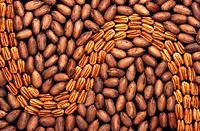
Uses
Hickory wood is extremely tough, yet flexible, and is valued for tool handles, bows (like yew), wheel spokes, carts, drumsticks, Lacrosse stick handles, golf club shafts (sometimes still called hickory stick, even though made of steel or graphite), the bottom of skis, walking canes etc. and for punitive use as a switch or switch (rod) (like hazel), and especially as a cane-like hickory stick in schools. Baseball bats were formerly made of hickory but are now more commonly made of ash. Hickory is also highly prized for wood-burning stoves, because of its high caloric content. Hickory wood is also a preferred type for smoke curing meats. In the Southern US, hickory is popular for cooking barbecue, as hickory grows abundantly in the region, and adds flavor to the meat. Hickory is sometimes used for hardwood flooring due to its durability and character.
A bark extract from shagbark hickory is also used in an edible syrup that is similar to maple syrup, with a slightly bitter, smoky taste.
The nuts of some species are palatable, while others are bitter and only suitable for animal feed. Shagbark and Shellbark Hickories, along with the Pecan, are regarded by some as the finest nut trees.
When cultivated for their nuts, note that because of their self-incompatibility, clonal (grafted) trees of the same cultivar cannot pollinate each other. Two or more cultivars must be planted together for successful pollination. Seedlings (grown from hickory nuts) will usually have sufficient genetic variation.
See also
- walnut (also used in waterskis)
External links
- Carya Large-format diagnostic photos, Morton Arboretum acc. 29-U-10
- Flora of North America: Carya
- Flora of China: Carya
- USDA Agricultural Research Service: Carya
- Edibility of different species' nuts, from a snack food manufacturer
- Comparison of eastern North American hickories at bioimages.vanderbilt.edu
- Comparison of hickory nuts at bioimages.vanderbilt.edu
Credits
New World Encyclopedia writers and editors rewrote and completed the Wikipedia article in accordance with New World Encyclopedia standards. This article abides by terms of the Creative Commons CC-by-sa 3.0 License (CC-by-sa), which may be used and disseminated with proper attribution. Credit is due under the terms of this license that can reference both the New World Encyclopedia contributors and the selfless volunteer contributors of the Wikimedia Foundation. To cite this article click here for a list of acceptable citing formats.The history of earlier contributions by wikipedians is accessible to researchers here:
The history of this article since it was imported to New World Encyclopedia:
Note: Some restrictions may apply to use of individual images which are separately licensed.
